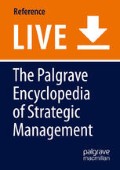Abstract
We discuss the differences between incumbent firms and new entrants, indicating their heterogeneity in terms of technological capabilities, complementary assets and cognitive frames. Moreover, we highlight the heterogeneity within new entrants, based on their firm-level prior experience in related industries or their founder-level prior experiences as academics, users or ex-employees of existing firms.
This entry was originally published on Palgrave Connect under ISBN 978-1-137-49190-9. The content has not been changed.
References
Agarwal, R., and S.K. Shah. 2014. Knowledge sources of entrepreneurship: Firm formation by academic, user and employee innovators. Research Policy 43: 1109–1133.
Agarwal, R., R. Echambadi, A.M. Franco, and M. Sarkar. 2004. Knowledge transfer through inheritance: Spin-out generation, development, and survival. Academy of Management Journal 47: 501–522.
Bayus, B.L., and R. Agarwal. 2007. The role of pre-entry experience, entry timing, and product technology strategies in explaining firm survival. Management Science 53: 1887–1902.
Carroll, G.R., L.S. Bigelow, M.D.L. Seidel, and L.B. Tsai. 1996. The fates of de novo and de alio producers in the American automobile industry 1885–1981. Strategic Management Journal 17: 117–137.
Chen, P.-L., C. Williams, and R. Agarwal. 2012. Growing pains: Pre-entry experience and the challenge of transition to incumbency. Strategic Management Journal 33: 252–276.
Christensen, C.M., and J.L. Bower. 1996. Customer power, strategic investment, and the failure of leading firms. Strategic Management Journal 17: 197–218.
Cooper, A.C., and D. Schendel. 1976. Strategic responses to technological threats. Business Horizons 19: 61–69.
Ganco, M., and R. Agarwal. 2009. Performance differentials between diversifying entrants and entrepreneurial start-ups: A complexity approach. Academy of Management Review 34: 228–252.
Gort, M., and S. Klepper. 1982. Time paths in the diffusion of product innovations. Economic Journal 92: 630–653.
Helfat, C.E., and M.B. Lieberman. 2002. The birth of capabilities: Market entry and the importance of pre-history. Industrial and Corporate Change 11: 725–760.
Helfat, C.E., and R.S. Raubitschek. 2000. Product sequencing: Co-evolution of knowledge, capabilities and products. Strategic Management Journal 21: 961–979.
Henderson, R.M., and K.B. Clark. 1990. Architectural innovation: The reconfiguration of existing product technologies and the failure of established firms. Administrative Science Quarterly 35: 9–30.
Khessina, O.M., and G.R. Carroll. 2008. Product demography of de novo and de alio firms in the optical disk drive industry, 1983–1999. Organization Science 19: 25–38.
King, A.A., and C.L. Tucci. 2002. Incumbent entry into new market niches: The role of experience and managerial choice in the creation of dynamic capabilities. Management Science 48: 171–186.
Klepper, S., and K.L. Simons. 2000. Dominance by birthright: Entry of prior radio producers and competitive ramifications in the US television receiver industry. Strategic Management Journal 21: 997–1016.
Klepper, S., and S. Sleeper. 2005. Entry by spin-offs. Management Science 51: 1291–1306.
Mitchell, W. 1989. Whether and when: Probability and timing of incumbents entry into emerging industrial subfields. Administrative Science Quarterly 34: 208–230.
Rothaermel, F.T., and C.W.L. Hill. 2005. Technological discontinuities and complementary assets: A longitudinal study of industry and firm performance. Organization Science 16: 52–70.
Schumpeter, J.A. 1942. Capitalism, socialism, and democracy. New York: Harper.
Shah, S.K., and M. Tripsas. 2007. The accidental entrepreneur: The emergent and collective process of user entrepreneurship. Strategic Entrepreneurship Journal 1: 123–140.
Shane, S.A. 2004. Academic entrepreneurship: University spin-offs and wealth creation. Cheltenham: Edward Elgar.
Teece, D.J. 1986. Profiting from technological innovation. Research Policy 15: 285–305.
Tripsas, M. 1997. Unraveling the process of creative destruction: Complementary assets and incumbent survival in the typesetter industry. Strategic Management Journal 18: 119–142.
Tripsas, M., and G. Gavetti. 2000. Capabilities, cognition, and inertia: Evidence from digital imaging. Strategic Management Journal 21: 1147–1161.
Tushman, M.L., and P. Anderson. 1986. Technological discontinuities and organizational environments. Administrative Science Quarterly 31: 439–465.
Author information
Authors and Affiliations
Corresponding author
Editor information
Editors and Affiliations
Copyright information
© 2016 The Author(s)
About this entry
Cite this entry
Agarwal, R., Moeen, M. (2016). Entrepreneurial Startups (de novo), Diversifying Entrants (de alio) and Incumbent Firms. In: Augier, M., Teece, D. (eds) The Palgrave Encyclopedia of Strategic Management. Palgrave Macmillan, London. https://doi.org/10.1057/978-1-349-94848-2_81-1
Download citation
DOI: https://doi.org/10.1057/978-1-349-94848-2_81-1
Received:
Accepted:
Published:
Publisher Name: Palgrave Macmillan, London
Online ISBN: 978-1-349-94848-2
eBook Packages: Springer Reference Business and ManagementReference Module Humanities and Social SciencesReference Module Business, Economics and Social Sciences

